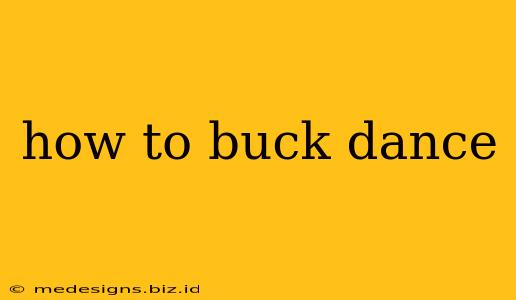Buck dancing, a vibrant and energetic American folk dance, is characterized by its rhythmic footwork and expressive body movements. While it might seem complex at first glance, with practice and dedication, anyone can learn to buck dance. This guide will break down the fundamentals, helping you take your first steps towards mastering this captivating dance style.
Understanding the Basics of Buck Dancing
Buck dancing's roots lie in the Appalachian region, evolving from various influences, including Irish step dancing and African American traditions. It's a highly improvisational dance, meaning there's no single "correct" way to do it. The focus is on the rhythmic precision of your feet and the playful, expressive energy you bring to the performance.
Key Elements of Buck Dancing:
- Footwork: This is the heart of buck dancing. It involves a rapid succession of steps, shuffles, and taps, often performed with a quick, percussive sound. The feet are constantly in motion, creating a complex and rhythmic pattern.
- Upper Body: While the footwork is crucial, the upper body also plays a significant role. Many buck dancers incorporate arm movements, shoulder shrugs, and torso twists to add visual flair and emphasize the rhythm. This upper body movement adds a dynamic dimension to the dance.
- Rhythm: A strong sense of rhythm is essential. Buck dancing is typically performed to upbeat, often percussive music, and the dancer's movements need to synchronize with the music's beat. Practice keeping time!
- Improvisation: Don't be afraid to experiment! Buck dancing thrives on improvisation. Once you have the basic steps down, try adding your own variations and flourishes to create a unique and personal style.
Learning the Basic Steps of Buck Dancing
While there are many variations, let's focus on some foundational steps to get you started:
The Shuffle:
- Begin with your feet shoulder-width apart.
- Shift your weight to your right foot, sliding your left foot slightly to the right.
- Shift your weight to your left foot, sliding your right foot slightly to the left.
- Repeat this sequence, maintaining a steady rhythm. Practice this until you can perform it smoothly and with consistent speed.
The Heel-Toe:
- Start with your feet together.
- Step forward with your right foot, placing your heel down first, then your toe.
- Step forward with your left foot, placing your heel down first, then your toe.
- Repeat, keeping the rhythm even.
Combining Steps:
Once you're comfortable with the shuffle and the heel-toe, try combining them. Experiment with different sequences and rhythms. You can transition seamlessly from one step to the other, creating more complex patterns.
Tips for Improving Your Buck Dancing
- Practice Regularly: Consistent practice is key to mastering any dance style, including buck dancing. Even short, regular sessions are more effective than infrequent, longer ones.
- Listen to the Music: Pay close attention to the rhythm and tempo of the music. Let the music guide your movements.
- Watch Videos: Observe experienced buck dancers. Pay attention to their footwork, upper body movements, and overall style. YouTube is a great resource for finding instructional videos.
- Take a Class: If possible, consider taking a buck dancing class from a qualified instructor. They can provide personalized feedback and guidance.
- Find Your Style: Don't be afraid to experiment and develop your own unique style.
Beyond the Basics: Exploring Buck Dancing's Variations
As you improve, explore the many variations and styles of buck dancing. You'll discover different footwork patterns, upper body movements, and ways to express yourself through this captivating dance form. The key is to have fun and let your personality shine through! Embrace the improvisation and let your creativity flow. Buck dancing is a journey of continuous learning and self-expression.
With dedication and practice, you’ll soon be tapping your way to mastering this dynamic and rewarding dance style. So put on some music, loosen up, and start shuffling!
